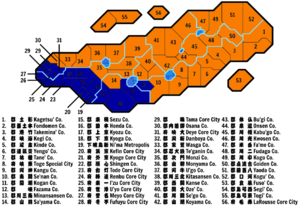Nijima
Nijima (新島, Niijima?, "new island"), formerly also known as Port Impregnable, is an island in the Skerry Isles located west of Incontinentia, which was once part of the Hoennese Realm. It is currently divided between the Order of the Holy Lakes (Phinbella/Hurmu; see Territory of Western Nijima) and Constancia.
It was the location of the Humanitarian Mission in former Nijima on 22.VIII.1680.
Name
Nijima or Niijima means "new island" in the closely-related Sangunese and Hoennese languages, respectively. The difference is due to the fact that Hoennese doesn't distinguish vowel length, while Sangunese does. Sometimes, the Latin transliteration follows the Hoennese rules (“Nijima” or “Niɂma”, with one I), and sometimes (more often in the past), it follows the Sangunese rules ("Niijima" with two Is). In Hoennese, the name has three morae (Ni·ɂ·ma) but two syllables, while in Sangunese it has four morae (Ni·i·ji·ma).
The Jing reading of the name is Xīndǎo, and the Taesongean reading is 신도 Sindo.
History
Hoennese rule
Between 1675 AN and 1680 AN, Nijima was governed independently as a direct successor state to the Hoennese Realm. Independent Nijima's collapse led to the Humanitarian Mission in former Nijima.
Constancian settlement
Noticing the need for closer shipping stations to bridge the gap between Zylenisí and the Santander and Wechua markets, on the withdrawal of Hoennese sovereignty, a group of investors gathered into a chartered corporation known as the Company of Merchant Adventurers to New Lands in order to take advantage of this opportunity. Upon establishment of Constancian sovereignty over the island on I.1690, preparations for survey and assessment were made.
On 19.I.1690 the young Ardashir-e Bābakān Osman, Khanzada of Raspur, arrived on the island to assume the governorship and the command of the General Service Corps assets deployed in the region. His brief, received from Trans-Euran Command, was to commence the cleansing of the island of Nijima of all forms of non-human sapient life following the recognition of a Constancian claim to the greater part of that island on the part of the international arbitration authority. This grand hunt was to be undertaken as an act preparatory for the plantation of new settlements.
On 22.I.1690, the Company publicly announced via The Economic Intelligencer, the newspaper of commercial record in The Imperial State of Constancia, that it was seeking individual members of the public who were interested in investing 9,301,000 Natopos in exchange for 1 share of the Company, to which the shareholder would be receive 1,000 acres of land of the Company. The Company made it a rule that only shareholders of the Company are permitted to receive land of the Company, and that settlers of the land shall have inalienable rights to liberty of worship. The Company shall govern the affairs of the land, to which shareholders, by virtue of being so, shall have inalienable seat, voice and vote at the Annual General Assembly and election of the Court of Directors. Land was also to be granted in fee simple, which generated sufficient interest from prospective investors.
The unique legal framework for this new territory caused a flurry of excitement among many high net worth individuals and corporations, which also led to enthusiastic investment. Public disclosures revealed that the Company has issued 1 share each to the following individuals, corporations, and corporations sole: the Prince of Molivadia, the Princess of Arboria, the Lord of Delfinenstrand, Jaime Augustin Joaquin Primo de Aguilar, Esmeralda al-Osman de Aguilar, the Osman-Aguilar Holdings Corporation, and the Micras Chovgan-Tzykanion-Polo Federation.
Further public disclosures also indicate that the Company subscribed to 5,000,000,000 Natopos worth of asset-backed commercial paper of the Oranjesion Private Equity Capital corporation, a 6,000,000 Natopo cash deposit to an undisclosed brokerage account in the Constancian Commercial Exchange Corporation, as well as a donation of 800,000 to the Arboria Polo Federation, and another donation of 13,000 to the Imperial Constancian Tzykanion Association.
A formal Autokratorial Charter [1] was granted and promulgated on 6.XI.1690, which formally declared the new island and the lands therein as a protectorate of the Imperial State of Constancia, but under the direct government of the Company, as well as the establishment of Augustinium, a new settlement, on the coastal land of the company, not to exceed 576 square kilometers, directly governed by the Imperial State through the Thema Oranjesion.
In 1694, the Andronikos-class auxiliary cruisers KP Ilion and KP Oréstis were detached from Nivardom Command and transferred to the operational control of Zylenisí Command, along with KP Andromákhē, which was given the role of guard ship for Nijima.
Orders were also issued to the Imperial Constancian Air Force to establish a Control and Warning Station in Mirran, Zylenisí, placing them under the operational control of Keltia Command, while providing information to Trans-Euran Command. The Merarahia Pezonauton (Marine Division) of the Imperial Constancian Army deployed a company-strength detachment to Augustinium for internal security and military aid to the civil power missions.
Governance
The island, excepting the 576 square kilometer settlement of Augustinium, is governed by the Court of Directors of the Company, who are themselves elected for an annual term by the shareholders of the Company.
Economy
Subsistence fishing, subsistence agriculture and some hunting were the primary economic activities on the island between the state failure of Nijima and the assertion of Constancian sovereignty. In 1697, a branch of Patti's opened in Augustinium.
Military and security
Constancian sector
Holy Lakes sector
